In one late autumn night a few years ago, one of our ewes gave birth to two lambs that unfortunately suffered hypothermia. A week of caring for the lambs made me fond of them. I even named them – Lola and Chumi. However, one morning, they went missing from our shed and my dad said it was coyotes. My frustration was shared by other livestock owners whose farms were also raided by coyotes that winter.
I felt the need to keep these predators out of our property (and out of our lives for good). So, I decided to take part in coyote hunting with some friends. There are many techniques and strategies involved in coyote hunting since they are smart creatures and we do need to be smarter than them.
To outwit these wild predators, not only do we need the right approach but also the right hunting equipment. A good predator call is one of them. However, there are so many options on the market with varying features. How do you single out the most effective one of all?
We reviewed the best coyote calls for sale today and shared our findings right here! Go through our review and buying guide and see which one works well for you.
Our Reviewed Best Coyote Calls
1 Icotec Gen2 GC300 Electronic Predator Call (Top Pick)
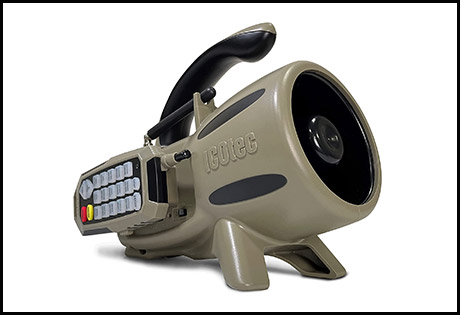
Icotec Gen2 GC300 does what it’s supposed to do very well. It features 12 animal call sounds, including coyotes and their favorite prey – rabbits and fawns. Equipped with a durable casing, the call speaker is supported by a tripod mount.
It comes with a remote control with button lights for night hunting. The best part is that it’s capable of playing two simultaneous sounds. The remote can regulate the loudness of the call and there is a Play and Stop button. It also boasts of strong, wide-range connectivity to its speaker with long battery life.
The GC300 is easy to operate and the dual simultaneous call is a huge plus. It makes the calls more natural and tricks coyotes into thinking that the calls are real. We were also amazed at how far the remote managed to stay connected to the speaker. We were 100 yards out and the speaker still worked perfectly; i.e., the call was heard clearly from our station.
The GC300 has strong housing but is surprisingly lightweight. We took it on multiple stands without having to worry about the weight or battery power. The call was as loud on the sixth stand as it was on the first.
This device may not be equipped with a decoy but its durable build makes up for that. The downsides are that there is no room for additional sounds to be installed and the buttons are easily pressed that you won’t like when you’re about to lure some coyotes in your shooting range. But we actually can’t complain because after all, it comes at an economical price with a 1-year warranty.
Specifications
- Plays 30-40 seconds call in intervals of 20 seconds
- Speaker operates on 1.5V AA batteries
- Remote uses 23A battery
- Around 40 hours calling time
- 300-yard remote control range
Pros
- Lightweight
- Durable
- User-friendly
- Long battery life
- Relatively cheap
Cons
- Not programmable
- Easily pressed buttons
Our Verdict
Having gone through a rigorous testing session on this particular call, we can safely state that it’s a treasure trove for both beginner and seasoned hunters. The price is reasonable for those who are working on a budget. Whether your purpose is hunting or research, you are in for a pleasant experience with the Icotec GC300. This modern piece of technology is sure to bring in more coyotes than your expectation. Give the Icotec Gen2 GC300 a try and see how it works for you.
2 Primos 372 Predator Call by Randy Anderson
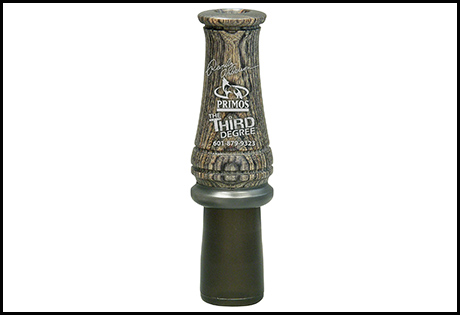
The Primos 372 is a top-of-the-line hand and mouth predator call designed by the famous veteran coyote hunter, Randy Anderson. It is capable of generating loud, high-pitched, raspy sounds that closely imitates a cottontail rabbit’s distress call.
This open reed call lets you make the most of Randy Anderson’s three stages of calling. Its high-pitched sound is capable of luring in coyotes and other predators far away. The Primos Team guarantees an extraordinary performance with the 372 even in the toughest environment.
We noticed that other hand and mouth calls often release a distorted sound when blown too loud. But this was not the case with the Primos 372 that produced steady, clean pitches. Because it’s open reed, we were able to mimic real animal distress sounds that made it one of our most favorites.
The sound that this caller produces seems real to the untrained ear. It remains true to its claim of performing well even in the toughest conditions. Being small and compact, it was also easy to pack and didn’t create too much fuss.
Specifications
- Laminated barrel
- Open reed
- Dimensions (LxWxH): 1.25 x 3.50 x 7.50 Inches
Pros
- Small
- Loud
- Produces realistic cottontail rabbit sound
Cons
- Not for beginners
- Requires knowledge on mouthing techniques
Our Verdict
Primos 372 does live up to its name. Not only does it create loud sounds with less effort, but it sounds real too. With this as our hand-held call, we were able to save enough energy to endure the long hunting session.
However, you need to learn the right mouth and palm technique to get better results. That’s why this will be a bit trialing for beginners but nothing too difficult to master with a few practices. This is a call you need to take with you in all your hunting adventures.
3 iHunt Ultimate Electronic Game Call & Bluetooth Speaker Combo, EDIHGC
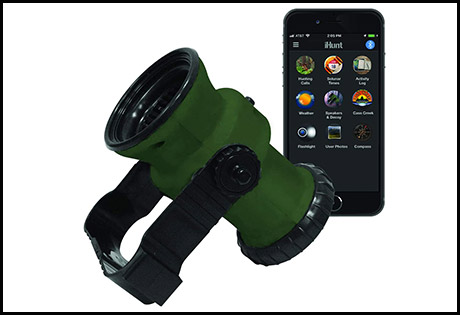
Young hunters usually look forward to using more compact hunting equipment, and iHunt Ultimate is a great choice in this regard. There’s an app that allows you to use your phone as a remote for your electronic game call.
Downloadable from Google Play Store and Apple iTunes, the app allows you to stay connected to the speaker via Bluetooth up to a maximum distance of 50 yards. Its solid speaker casing and reliable circuitry are built to meet the outdoor hunting demands.
You will be given access to a total of 750 calls from 59 animal species. Apart from the wide animal call selection, the app also has other useful features like weather forecast, lunar calendar, and compass to mention a few.
The iHunt Ultimate Combo is another practical choice for young guns to explore the wild. But we noted that the speakers worked best when the device was off the ground. For better Bluetooth connectivity, keep the speaker hanging from a tree branch.
Specifications
- Weight: 1.54 lbs.
- Bluetooth connection
- 50-yard connectivity
- 750 animal call selections
- Dimensions (LxWxH): 25 x 6.25 x 10.5 inches
Pros
- Great pricing
- Speaker designed especially for outdoor activities
- Lightweight
Cons
- Foliage can affect connectivity
- Speaker can connect only to one device at a time
Our Verdict
Hunting does not get more practical with the iHunt Ultimate Combo. This is not only for the rookie coyote hunters who wish to make their experience smooth and easy. This is also a hybrid technology that veteran coyote hunters might enjoy to increase their time in the field and out of town all year long, not just the fall.
The price of the device combined with the phone application does not create even a dent in your wallet. To the wise and tech-savvy hunters, we might say, happy hunting with iHunt Game Call Combo!
4 Lucky Duck E-Caller
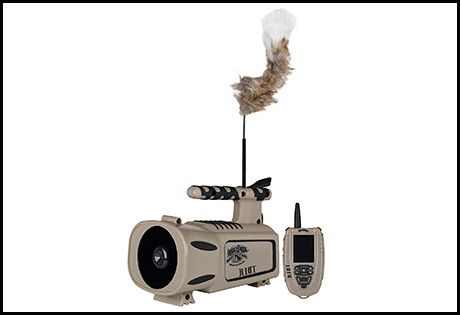
One coyote caller with a decoy that stands above the rest is the Lucky Duck Riot E-Caller. This popular predator caller has 50 preloaded animal sounds recorded by Rick Paillet, also known as, The Verminator. It can save a maximum of 2,000 animal calls.
Apart from its usual Pause and Play buttons, this item has a remote control that can distort sounds. Its affordable and lightweight set-up comes with a motorized antenna where a decoy can be attached. This unit is powered by 10 AA batteries plus three more for the remote.
We believe Lucky Duck has done a good job with the Riot E-Caller. Its expansive animal sound library makes it one of our top choices. Not only that, this electronic caller brings with it a remote control with a long-range capacity. We were able to find the perfect station at a proper distance without worrying about connectivity.
The motorized decoy takes hunting to a new level. Producing a variety of animal sounds while flailing the decoy is sure to fool even the most cunning coyotes or any predator for that matter. Additionally, the sound distortion feature of the remote will allow the caller to better imitate an animal in distress.
Specifications
- Compact Design (remote and decoy storage in the caller)
- 300-yard remote control range
- Motorized decoy
- 50 preloaded sounds
- Maximum sound library capacity: 2,000 (MP3, WAV, and LD format)
- AUX speaker jack
Pros
- Lightweight
- Long-range connectivity
- Relatively cheaper
- Remote with easy recall buttons
Cons
- Tripod not included in the package
Our Verdict
The Riot E-Caller is definitely a worthy investment. Its lightweight and compact structure will allow you to care it easily when traveling to several hunting locations. Despite being a cheap model in The Lucky Duck’s line of electronic callers, it has proven to be a reliable hunting companion for us. We believe you’ll also have the same experience with the Lucky Duck Riot E-caller.
5 FoxPro Hammer Jack Electronic Predator Call
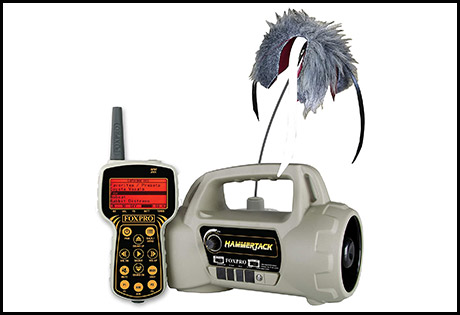
Another amazing user-friendly electronic caller with a decoy is the FoxPro Hammer Jack. This e-caller comes with 100 free call sounds and a transmitter with multi-function features.
For less than $300, this lightweight product packs dual-amplified speakers. The front horn speaker creates high-pitched sounds (e.g. coyotes and distress calls) while the rear cone speaker generates low-frequency sounds (e.g. bear growls), topped by its motorized Fuzzy Wuzzy Decoy.
This unit comes with a lot of high specifications, including a 4GB memory reserved to accommodate a maximum of 300 calls. The operating range of the transmitter is wide enough at 200 yards. It does deliver loud, realistic call sounds and if one speaker is not enough for you, you can always add another external speaker using the auxiliary jack. Its transmitter has multi-function features but the device is easy to operate.
We chose FoxPro Hammer Jack not only for its physical features but its premium 3-year long warranty period as well. You don’t get that so often at this price range. FoxPro Hammer Jack e-call is a little more expensive than the Riot E-Caller but its amazing features makes up for that extra cost. What’s more, this is an American made product that you might be proud of.
Specifications
- Weight: 3.50 lbs.
- Front: Horn speaker
- Rear: Cone speaker
- 200-yard connectivity
- Preloaded with 100 animal call sounds
- Reprogrammable
- Run Time: 3-7 hours
Pros
- Portable and lightweight
- Dual-amplified speakers
- Expandable to a maximum of 300 animal call selections
- With a premium product warranty
Cons
- Moderate battery life
- Not waterproof
Our Verdict
FoxPro Hammer Jack call has proven to be an effective hunting call no matter where we put it to use. Its speakers are capable of producing high-and low-frequency sounds that effectively imitate various animal calls. The long warranty makes this a reliable choice. All in all, we can say that the FoxPro Hammer Jack is a good buy.
Coyote Hunting Call Buying Guide
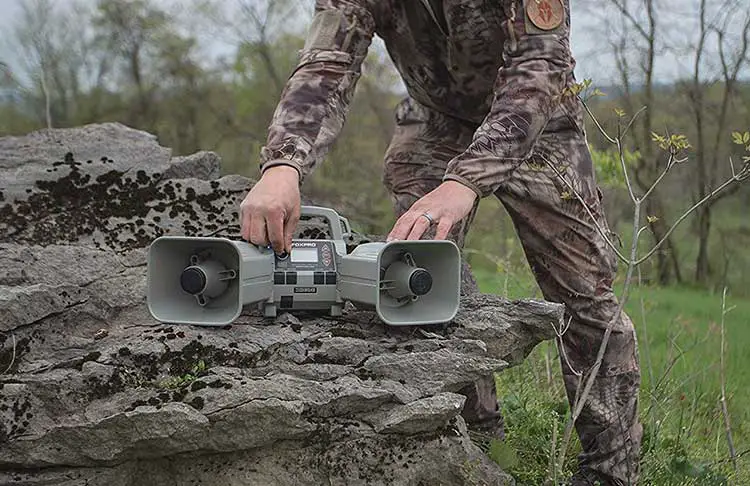
1. Types
There are three types of coyote calls for you:
a) Diaphragm Calls
If you’re a budget-conscious coyote hunter that wants to go light, the diaphragm caller may be just what you need. Diaphragm calls are small rainbow-shaped frames with a latex rubber in the middle called the reed (similar to the size of a cookie).
The diaphragm sound is created from the force of air from your lungs passing through the space between your tongue and the reed. There are several kinds of diaphragm calls depending on the cut (to help produce flexible and raspy sounds), tension (to determine pitch), and the number of reeds (to determine loudness).
It must fit your mouth properly to be able to make an effective call. The shape of your palette and the size of your mouth will affect how effectively you might be able to create the desired sound. If you have a small buccal profile, you may try the diaphragm youth calls. For starters, using the single or double reed is best when learning how to make a proper call.
b) Hand and Mouth Calls
Another cheap and hassle-free option for avid coyote hunters is the hand-held predator call. Just slip it in your pocket and you’re good to go. Hand and mouth calls come in two types defined by the structure. If you are considering using the hand and mouth calls, here are some pointers for you to go over:
- Closed Reed – reed is enclosed in the device
- Easy to use
- Easy to master
- For beginners
- Mimics sound of distressed rabbits
- Lacks flexibility
- Open Reed – reed is exposed
- Produces a variety of calls
- Takes time to master
- Requires mouth and palm techniques
- Mimics a wide variety of sounds
c) Electronic Calls
If you’re new to this sport, we recommend that you get an electronic call. E-calls could be pricier than their diaphragm and hand-held counterparts, but they’re sure to help you bag a few games. Electronic calls are also easier to work with but require a little bit of preparation and maintenance to make sure they’ll back you up throughout the whole hunting expedition.
2. Programmability
Since electronic callers can store pre-recorded animal sounds, this means their performance level is also affected by their capacity to store data. Although most e-calls can be reprogrammed nowadays, some are not programmable. They are limited to the number of calls pre-installed in the system.
3. Amplification
The capacity at which a call can intensify the sound is also important. When a hunter wishes to attract predators like coyotes, even from a long distance, their call must be able to amplify the sounds enough to catch their attention. Some electronic calls have a dual-speaker system that allows each speaker to generate both high-and low-frequency sounds.
4. Range
The range is the area or distance at which frequency travels effectively. In the case of e-callers, most of them come with a remote control or transmitter. This allows you to control the caller’s activity from a distance. The range of electronic calls vary from as near as 50 to as far as 300 yards, and possibly even more.
5. Battery Life
For electronic callers, this refers to the amount of time your device can run before the battery power runs out. Most of today’s e-calls are run on rechargeable lithium batteries. They do not always come with the package though, so be sure to ask the seller. Some e-calls have a long-lasting battery while others don’t. E-calls usually have LED lights installed that indicate if battery life is running low.
6. Speakers
The speakers are one of the most crucial parts of an effective electronic caller. The higher the quality of the speakers, the better the quality of the sounds. Good quality speakers produce clear, crisp, realistic sounds.
7. Remote Control
The remote control is a crucial piece of the electronic call equipment as it controls the progression of calls. Some remote controls have fewer complex features and some require more familiarization as it displays multi-functionality.
8. Weight
In hunting, the mass of the electronic call matters very much since you carry them around. Hunters do not usually stay just in one location. They constantly change their position in search of a good hunting ground. A lightweight (and preferably durable) electronic caller is needed for easy movements.
9. Warranty
Electronic callers usually come with a 1-year warranty. However, the high-end ones often have a premium coverage of three years.
10. Price
The extensive selection of electronic calls on the market also comes with a wide range of prices; i.e., from just $20 to as much as $700.
How to Use Electronic Calls for Hunting Coyotes?
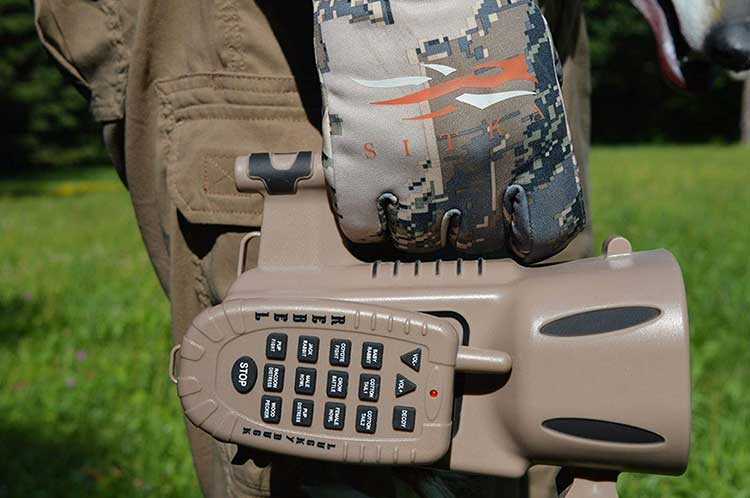
Hunting is not only a game of patience, it is also a test of wits. Coyotes are smart creatures that learn quickly from their experience. Those that have survived a few failed hunting attempts tend to be cautious. Catching coyotes is a tricky affair which is why it’s important to have the right equipment and knowledge on how to use them.
First thing’s first. Make sure the area you’re hunting in has coyotes living within the territory. Looking for cues like coyote prints and scats will help you determine if the terrain is what you’re looking for.
Set up your electronic caller and find a well-hidden spot upwind. Be sure to wear comfortable clothing that blends well with your surroundings (preferably camouflage). Stay as far from the caller as the remote range allows you to. You can also use decoys that show wind direction like the turkey feather.
Choose the correct combination of call sounds and play at the right intervals. Calls made with too close intervals might scare away the coyotes nearby. Open areas will need louder sounds. Start with a quarter of the volume and go higher as needed.
As seasoned hunters, we like to tickle the imagination of coyotes and other predators. We paint a picture of territory intrusion and hunting to force these predators to expose themselves in the open.
Mixing a wide variety of complementing, realistic animal sounds helps deceive even the most cunning coyotes. Study the list of sounds you have on your e-call and find a combination that works well. We’ve already set our foundation on the sounds we use and it works every time. Your techniques matter as much as the best coyote call you own.
FAQs
1. What are the differences between smaller and bigger e-callers?
Ans: The differences between smaller and bigger e-callers lie in their portability, price, and volume. It will be much difficult to transport a bigger electronic call unless you plan to hunt in just one place across a wide expanse of several miles.
2. Should I use an electronic or regular call?
Ans: For beginners, it is wise to use an electronic call. Hand-held calls require practice and mastery before becoming useful during an actual hunt. For veteran hunters, open reed hand and mouth calls will give you the control and variety you’ll need.
3. How long should you call for coyotes?
Ans: Seasoned hunters usually call for about 30 minutes. Sometimes they wait for as long as 45 minutes. If no coyote comes in that period, they will move on to the next spot.
4. What time of the day is best for calling coyotes?
Ans: This depends on the season. In Spring and Summer, coyotes search for food at night and in the wee hours of the morning. They take refuge in the darkness to avoid being spotted. While in Autumn and Winter, they are forced to come out during the day because foods are scarce during these seasons.


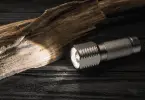
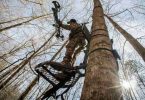


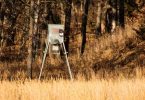

Leave a Comment